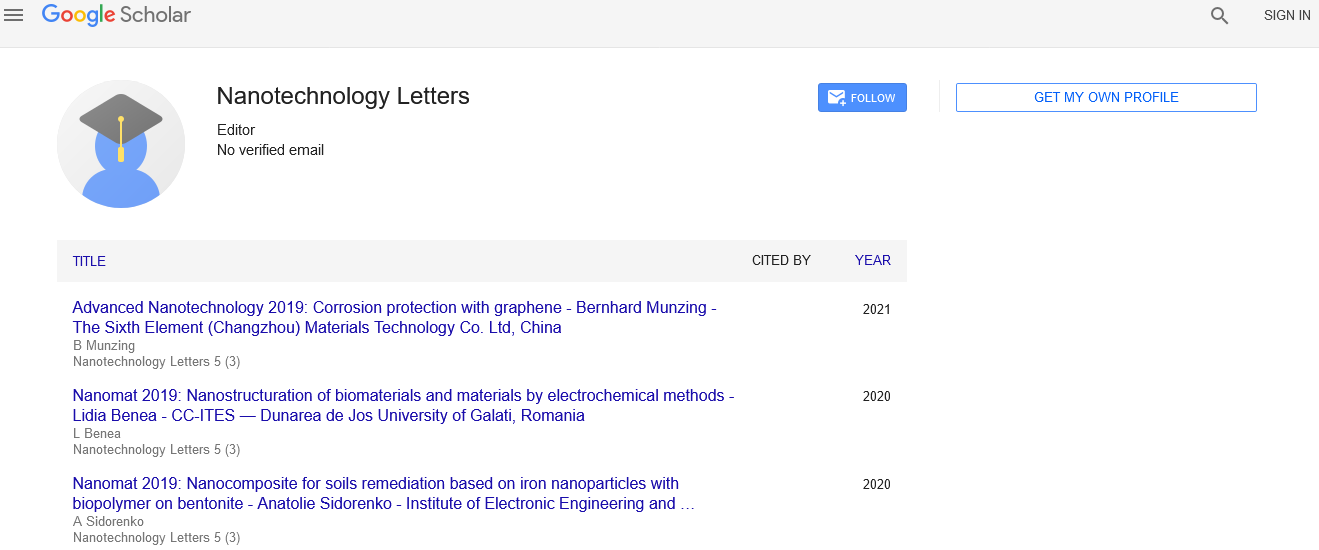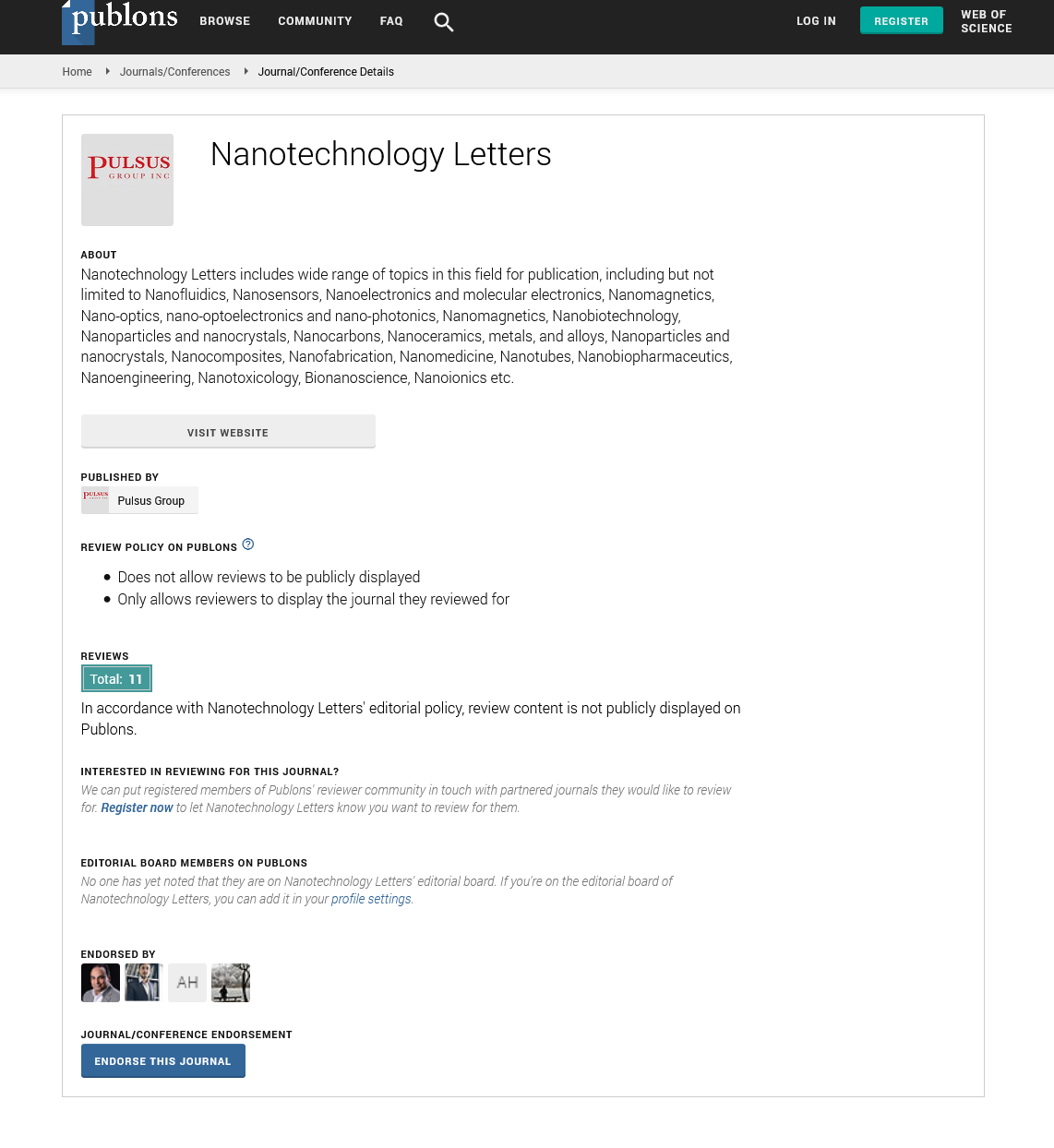Letters to editor on nanotoxicology for the journal of nanotechnology letters
Received: 21-Apr-2022, Manuscript No. pulnl-22-4816; Editor assigned: 23-Apr-2022, Pre QC No. pulnl-22-4816(PQ); Accepted Date: May 14, 2022; Reviewed: 07-May-2022 QC No. pulnl-22-4816(Q); Revised: 09-May-2022, Manuscript No. pulnl-22-4816(R); Published: 16-May-2022, DOI: DOI: 10.37532/ pulnl.22.6(2).1-2
Citation: Khan N. Letters to editor on nano toxicology for the journal of Nanotechnology Letters. Nanotechnol Lett.2022; 7(3):1-2
This open-access article is distributed under the terms of the Creative Commons Attribution Non-Commercial License (CC BY-NC) (http://creativecommons.org/licenses/by-nc/4.0/), which permits reuse, distribution and reproduction of the article, provided that the original work is properly cited and the reuse is restricted to noncommercial purposes. For commercial reuse, contact reprints@pulsus.com
Letter to Editor
I am deeply pleased to introduce the Journal of Nanotechnology Letters, an open-access, international peer reviewed journal aiming to provide an extensive research compendium on Nano fluidics, Nano sensors, Nano electronics and molecular electronics, Nano magnetics, Nano-optics, Nano-optoelectronics and Nano-photonics, Nano magnetics, Nano biotechnology, Nanoparticles and Nano crystals, Nano carbons, Nano ceramics, metals, and alloys, Nano medicine, Nanotubes, Nano bio pharmaceutics, Nano engineering, Nano toxicology, Bio Nano science, Nano Ionics etc. The journal of Nanotechnology Letters publishes up-to-date, high-quality and original research articles in conjunction with appropriate and perceptive reviews in the field of nanotechnology and its applications in various disciplines. Thus, promoting researchers, physicians, medical practitioners, students, post-doctoral fellows, scholars, academics etc. to utilize this platform for exploring recent developments in all areas of Nano science. The Journal follows a strict peer review process for each submitted manuscript to maintain high publishing standards and contributes to the early development and success of this journal All published articles of this journal are included in the indexing and abstracting coverage of Google Scholar, Directory of Open Access Journals, China National Knowledge Infrastructure (CNKI), Ulrich's Periodicals Directory, EBSCO A-Z, Geneva Foundation for Medical Education and Research, Free Medical Journals, Index Copernicus and CAS. In addition to its regular publication, Nanotechnology Letters had also scheduled several supplementary issues and brought out numerous Webinars and International conference on Nanotechnology, Nano biotechnology and Nano medicines. I would like to acknowledge and express my gratitude for the collective efforts of all the editors, authors, reviewers, publisher, language editors, honorary editors, scientific advisory and editorial board of Nanotechnology Letters for bringing out the new volumes/issues in time and look forward to their unrelenting support further to release more issues in scheduled time for publishing good quality and impactful publications. During this era, applications of nanoparticle has exponentially elevated such as being employed in textiles, pharmaceuticals, cosmetics and medicine.
Due to their exclusive properties, nanomaterial’s are now being considered as an empowering domain that serves as the basis for the development of novel Nano-based products in the scientific arena and worth millions in the commercial market. However, this perpetual usage of nanoparticles has intensified numerous environmental and health risks. And therefore, requires attentive evaluation in order to analyze their associated toxicological effects. Thus, the field of Nano toxicology is a need. Nano toxicology is the study of toxicity associated with nanoparticles. It is crucial to have information of resultant noxious effects of nanoparticles before employing it in any sort of viable application as the characteristics of nanoparticles are not always well recognized therefore hazard assessment should be done during their fabrication and use. Moreover, administrative Nano toxicological research upholds the advancement of standard conventions and new testing strategies to further strengthened the scientific foundations for decision-making process. Early stage nontoxicity identification is a challenging task because of numerous issues such as insufficiency of appropriate datasets, absence of applicable guidelines and incomplete classification of nanoparticles. However, determining nanoparticle related toxicity is required to detect their detrimental consequences on plants, animals, humans and the abiotic surroundings. To rationalize the current hazard and risk assessment process in terms of expenditure, it would require the evaluation of specific set of nanoparticles as a whole, without the necessity to exam each member of that set for every regulatory outcome. Moreover, number of animal-based experiments will be greatly reduced with regards to ethical considerations by encouraging research in Nano toxicology. In the end I would like to invite everyone to effectively participate and contribute to the journal of Nanotechnology Letters as authors, analyst, readers etc. and advocates for innovation and pioneer for change. Nanotechnology Letters has a strong research-based foundation and collectively, we can lead it to new heights.
Your Sincerely,
Nida Tabassum Khan






